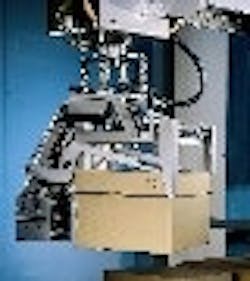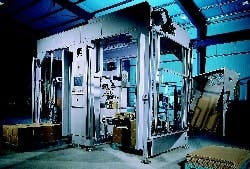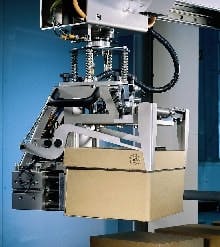Palletizer plugs and plays with packaging software
MANY MACHINES that used to be bolted to their various plant floors seem to be growing legs and walking around. Spooky? Not really, because this is just another manifestation of the flexible, modular, mobile, do-more-with-less engineering thats becoming standard operating procedure in U.S. manufacturing. Many machines are taking their capabilities on the road, or at least elsewhere in their factories and production lines.
Germany-based OEM Emkon Systemtechnik Projektmanagement GmbH recently wanted to build a mobile palletizer that could be moved from one line to another, and integrated into production flows quickly and easily. Our users needed a small-footprint palletizer that could drive one production line one day, and then drive another line the next day, says Andreas Dittrich, Emkons sales and marketing director. However, to achive this goal, the company required flexible controls that could synchronize quickly with a new production environment.
Consequently, Emkons PZ 1-K Android series palletizing unit was designed and developed to be a self-contained, turnkey, roller-mounted machine (See Figure 1 below). It can be used as a single, double, and multi-pallet station palletizer. A standard vacuum gripper takes individual, conveyor-fed products, and packs them singly or grouped in up to six pallet spaces, and stacks these for palletization according to a specified layout. It allows consistently flexible different palletizing layouts and the introduction of slipsheets.
We sought to make PZ 1-K as flexible as possible, and so it allows operators to put seven or eight products on the same pallet, says Dittrich. The slip sheet unit on the side of PZ 1-K is a new feature in palletizing that lets users put a sheet of paper between layers as needed.
Emkons PZ 1-K Android is designed to be a self-contained palletizer that can be integrated into a production line.
The control system uses a scalable hardware/software architecture based on the embedded PLC programming and runtime system. A key feature is the tight integration of motion control technology with a standardized PLC. SERCOS provides high-performance synchronization of the axes.
PZ 1-K uses a compact controller-based solution to provide intermediate functionality when operating with up to 16 servo axes. The system uses open standards such as IEC 61131-3 and PLCopen with specialized technology function blocks for linear six-axis interpolations for pick and place or for palletizing applications.
Up to 64 controllers can be networked via crosscommunication to provide precise synchronization of an entire line or process. In addition to 16 fast inputs and outputs, the controller base module offers standardized communication interfaces such as Ethernet, Profibus, RS-232, and SERCOS. The controller base modules can be expanded with additional communication interfaces or technology modules.
PZ 1-Ks process program is generated using Emkons offline palletizing system. The so-called handling module interprets the command syntax from the offline palletizing system and converts it into specified axis movements. This solution offers a greater degree of freedom for handling operations.
Besides being flexible and mobile on its own, PZ 1-K can be joined with other units in scaled-up applications. Users can buy one unit and easily add others, says Dittrich. In fact, we can cascade them into two to six pallet places, which makes this palletizer completely scalable to the users needs.
Problem and Solution
To design and build its PZ 1-K Android series palletizing unit, Emkon used:
- Scalable, single-architecture solution consisting of controllers, drives, motors, HMI, and development software
- IndraMotion for Packaging software from Bosch Rexroth with IndraControl L40 compact DIN rail mount controller
- IEC 61131-3 compliant PLC and PLCopen motion function blocks
- Full communications support for fieldbus, SERCOS, and Ethernet
Cost savings generated by PZ 1-K include:
- Cut machine cost 20%
- Reduce engineering, delivery and commissioning time more than 25%
- Slash engineering time 20%
- Decrease wiring costs 20-30%
- Trim control cabinet width 30%




